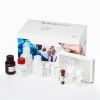Collectin-10, Human, ELISA – 1 x 96 det. - HK364-01
Collectin-10 can bind to carbohydrate ligands and DNA of pathogens or on the membrane of damaged cells. They interact with MASPs and activate in a similar way to MBL and ficolins the lectin pathway.
Quantity
1 x 96 det.
Catalog #
HK364-01
894,00 €
The complement system is the first line of defense against pathogens and important component of innate as well as adaptive immunity. The three major pathways of innate immunity are the classical, alternative and lectin pathway. Each pathway is activated in a different way. The lectin pathway recognizes foreign carbohydrates structures via MBL, ficolins and collectins. Collectin-10 (collectin liver 1/CL-L1), CL-K1 (collectin kidney 1/Collectin-11) and CL-P1 (collectin placenta 1/Collectin-12) are most recently discovered. Collectin-10 and Collectin-11 are quite homolog, have a classical collectin structure and are highly conserved in mammals. Collectin-10 and Collectin-11 can bind to carbohydrate ligands and DNA of pathogens or on the membrane of damaged cells. They interact with MASPs and activate in a similar way to MBL and ficolins the lectin pathway. Native Collectin-10 displays a calcium dependent binding pattern.
A conformational change in carbohydrate recognition domain (CRD) is indicated when the calcium ion is removed by chelation with EDTA. Collectins share a common multimeric structure leading to varying degrees of oligomerization. The chains consist of a collagen-like region, an alpha helicon neck domain and a CRD. Collectin-10 was originally found in hepatocytes but mRNA has also been found in placenta, adrenal glands, lung, small intestine and prostate. Initially it was thought to exist only as a cytoplasmic protein. Recent studies also show presence in circulation, either separately or in heteromeric complex with Collectin-11.
The average serum concentration is depending on the study, localization and health status of the population and is considered to be ~300ng/ml (range 200-500ng/ml) for healthy individuals. Collectin-10 is encoded by a gene called COLEC10 on chromosome 8. A few polymorphisms have been identified which can lead to increase (up to 40%) of the Collectin-10 serum concentration. In SLE patients Collectin-10 levels are decreased by approximately 20%. High levels of Collectin-10 are beneficial at time of kidney transplantation and is associated with increased long term overall mortality. Elevated levels have also been found in the early phase of acute liver failure and in cirrhosis. Due to (short) periods of microbial challenge fluctuations in Collectin-10 in healthy individuals are seen in a given period. In plasma higher levels of Collectin-10 are found than in serum (ca 30%).
A conformational change in carbohydrate recognition domain (CRD) is indicated when the calcium ion is removed by chelation with EDTA. Collectins share a common multimeric structure leading to varying degrees of oligomerization. The chains consist of a collagen-like region, an alpha helicon neck domain and a CRD. Collectin-10 was originally found in hepatocytes but mRNA has also been found in placenta, adrenal glands, lung, small intestine and prostate. Initially it was thought to exist only as a cytoplasmic protein. Recent studies also show presence in circulation, either separately or in heteromeric complex with Collectin-11.
The average serum concentration is depending on the study, localization and health status of the population and is considered to be ~300ng/ml (range 200-500ng/ml) for healthy individuals. Collectin-10 is encoded by a gene called COLEC10 on chromosome 8. A few polymorphisms have been identified which can lead to increase (up to 40%) of the Collectin-10 serum concentration. In SLE patients Collectin-10 levels are decreased by approximately 20%. High levels of Collectin-10 are beneficial at time of kidney transplantation and is associated with increased long term overall mortality. Elevated levels have also been found in the early phase of acute liver failure and in cirrhosis. Due to (short) periods of microbial challenge fluctuations in Collectin-10 in healthy individuals are seen in a given period. In plasma higher levels of Collectin-10 are found than in serum (ca 30%).
| Datasheet URL | https://www.hycultbiotech.com/wp-content/uploads/2022/06/hk364-0120.pdf |
|---|---|
| Quantity | 1x96det. |
| Quantity | 1 x 96 det. |
| Standard range | 0.4 to 25 ng/ml. |
| Detection level | 0.4 ng/ml |
| Working volume | 100 µl/well |
| Species | human |
| Cross reactivity | Mouse - Weak, Pig - Yes, Rat - Weak |
| Alias | Collectin liver protein 1; CL-L1; Collectin-34; CL-34 |
| Storage and stability | Product should be stored at 4 °C. Under recommended storage conditions, product is stable for at least six months. |
| Precautions | Note that this user protocol is not lot-specific and is representative for the current specifications of this product. Please consult the vial label and the Certificate of Analysis for information on specific lots. Also note that shipping conditions may differ from storage conditions.<br />For research use only. Not for use in or on humans or animals or for diagnostics. It is the responsibility of the user to comply with all local/state and federal rules in the use of this product. Hycult Biotech is not responsible for any patent infringements that might result from the use or derivation of this product. |
| Disease | Autoimmunity, Infectious diseases |




